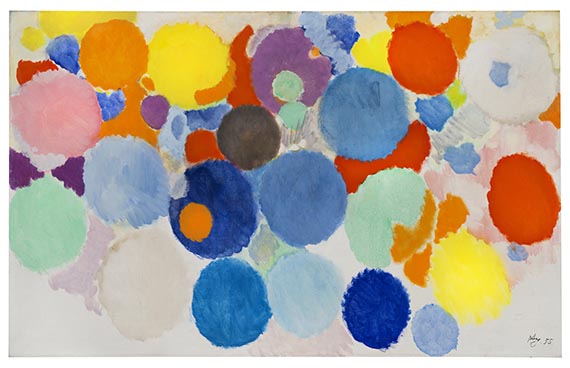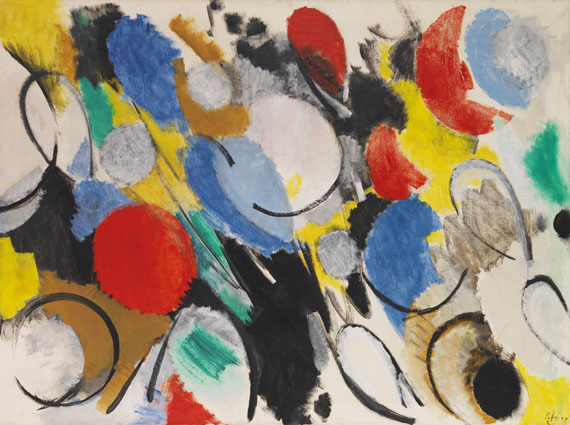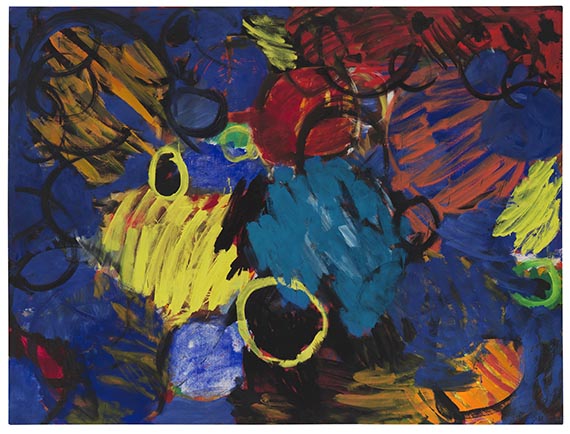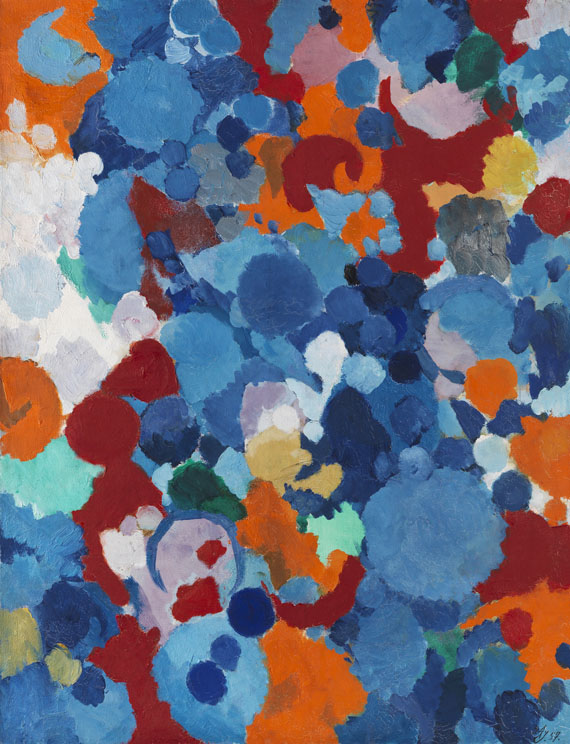Sale: 550 / Evening Sale, June 07. 2024 in Munich  Lot 124000198
Lot 124000198
 Lot 124000198
Lot 124000198
124000198
Ernst Wilhelm Nay
Ene mene ming mang, 1955.
Oil on canvas
Estimate:
€ 400,000 - 600,000
$ 428,000 - 642,000
Information on buyer's premium, taxation and resale right compensation will be available four weeks before the auction.
Ene mene ming mang. 1955.
Oil on canvas.
Lower right signed and dated. Once more signed on the reverse, stretcher inscribed "E. W. Nay - "Ene-mene-ming-mang" - 1955" and with the direction. 125 x 200 cm (49.2 x 78.7 in).
With a label of Galerie Günther Franke, Munich, on the reverse. [AR].
• Singular, cheerful lyrical work from the significant creative phase of the "Disk Pictures" - an inimitable synthesis of title and composition.
• The title alone, adopted from a traditional children's game, is an expression of sheer joy.
• The colors are vibrant and effective, a free, musical aesthetic with painted circular shapes.
• The disks, the motif of the disk, becomes the painterly determinant of a beautifully shaped pictorial rhythm.
PROVENANCE: Elisabeth Nay-Scheibler, Cologne.
Private collection North Rhine-Westphalia (since 1996).
EXHIBITION: E. W. Nay. Bilder aus den Jahren 1935-1968. Retrospektive, Museum Städtische Kunstsammlungen, Bonn, January 27 - March 1, 1970, cat. no. 22 (color plate).
E. W. Nay 1902-1968 – Bilder und Dokumente. Retrospektive, Germanisches Nationalmuseum, Nuremberg, March 29 - June 1, 1980, Haus der Kunst, Munich, July 26 - September 21, 1980, Erholungshaus der Bayer AG, Leverkusen, September 28 - October 30, 1980, Wilhelm-Hack-Museum, Ludwigshafen a. Rh., December 7, 1980 - February 1, 1981, Neue Galerie, Kassel, March 14 - May 10, 1981, cat. no. 36 (illu. no. 72, p. 129).
Ernst Wilhelm Nay, Stedelijk Museum, Amsterdam, April 30 - June 10, 1998, Gemäldegalerie Neue Meister, Dresden, July 19 - August 16, 1998, Wilhelm-Lehmbruck-Museum, Duisburg, August 23 - October 11, 1998, cat. no. 28 (illu. on p. 64).
LITERATURE: Aurel Scheibler, Siegfried Gohr, Ernst Wilhelm Nay. Catalogue raisonné of oil paintings, vol. 2: 1952-1968, Cologne 1990, no. 784 (color illu.).
Peter-Klaus Schuster, Kunst im Kontext: E. W. Nays ständige Wandlung,in: E. W. Nay - Bilder und Dokumente, Munich 1980, pp. 7-16, here p. 12 (illu. on p. 129).
Karin Schick, Kontakt. Zur Bedeutung von Sprache bei Ernst Wilhelm Nay, in: Karin Schick, Sophia Colditz, Roman Zieglgänsberger (ed.), E. W. Nay. Retrospektive, Cologne 2022, pp. 16-27, here p. 18.
Oil on canvas.
Lower right signed and dated. Once more signed on the reverse, stretcher inscribed "E. W. Nay - "Ene-mene-ming-mang" - 1955" and with the direction. 125 x 200 cm (49.2 x 78.7 in).
With a label of Galerie Günther Franke, Munich, on the reverse. [AR].
• Singular, cheerful lyrical work from the significant creative phase of the "Disk Pictures" - an inimitable synthesis of title and composition.
• The title alone, adopted from a traditional children's game, is an expression of sheer joy.
• The colors are vibrant and effective, a free, musical aesthetic with painted circular shapes.
• The disks, the motif of the disk, becomes the painterly determinant of a beautifully shaped pictorial rhythm.
PROVENANCE: Elisabeth Nay-Scheibler, Cologne.
Private collection North Rhine-Westphalia (since 1996).
EXHIBITION: E. W. Nay. Bilder aus den Jahren 1935-1968. Retrospektive, Museum Städtische Kunstsammlungen, Bonn, January 27 - March 1, 1970, cat. no. 22 (color plate).
E. W. Nay 1902-1968 – Bilder und Dokumente. Retrospektive, Germanisches Nationalmuseum, Nuremberg, March 29 - June 1, 1980, Haus der Kunst, Munich, July 26 - September 21, 1980, Erholungshaus der Bayer AG, Leverkusen, September 28 - October 30, 1980, Wilhelm-Hack-Museum, Ludwigshafen a. Rh., December 7, 1980 - February 1, 1981, Neue Galerie, Kassel, March 14 - May 10, 1981, cat. no. 36 (illu. no. 72, p. 129).
Ernst Wilhelm Nay, Stedelijk Museum, Amsterdam, April 30 - June 10, 1998, Gemäldegalerie Neue Meister, Dresden, July 19 - August 16, 1998, Wilhelm-Lehmbruck-Museum, Duisburg, August 23 - October 11, 1998, cat. no. 28 (illu. on p. 64).
LITERATURE: Aurel Scheibler, Siegfried Gohr, Ernst Wilhelm Nay. Catalogue raisonné of oil paintings, vol. 2: 1952-1968, Cologne 1990, no. 784 (color illu.).
Peter-Klaus Schuster, Kunst im Kontext: E. W. Nays ständige Wandlung,in: E. W. Nay - Bilder und Dokumente, Munich 1980, pp. 7-16, here p. 12 (illu. on p. 129).
Karin Schick, Kontakt. Zur Bedeutung von Sprache bei Ernst Wilhelm Nay, in: Karin Schick, Sophia Colditz, Roman Zieglgänsberger (ed.), E. W. Nay. Retrospektive, Cologne 2022, pp. 16-27, here p. 18.
"Ene mene ming mang" - und Du bist dran! (Similar to: Eeny, meeny, miny, moe,
Catch a tiger by the toe) Title and composition - a children's counting-out rhyme.
Even the title "Ene mene ming mang" promises a great deal of amusement. Literally an exception for a title that Ernst Wilhelm Nay gives to the completed painting in his final contemplation, associated with a delightful thought, reminiscent of a counting-out rhyme: 'Ene mene ming mang', the first sentence of the traditional children's rhyme that children use to count out a person in a game.
Nay himself described his path to the legendary compositions of the "Disk Paintings" in the following words: "So I started with innocuous new experiments and I realized: If I touch the canvas with a brush, I get a small blob, if I enlarge it, I get a disk. Of course, this disk already does a lot to the surface. If I add more disks, a system of colors and quantitative proportions emerges, which can now be combined and combined to form larger pictorial structures." (Magdalene Claesges, E. W. Nay. Lesebuch, Selbstzeugnisse und Schriften, Cologne 2002, p. 226).
Gestural forms and bright, circular splashes of color proliferate across the picture, taking on a lyrical, almost rhythmic form and reflect the artist's mood. Spots and densely painted circles in white, lemon yellow, dark yellow, orange, pink, light red, violet, light blue, dark blue, turquoise, light green and light gray bring the composition to life. The colors are colors are vibrant and effective, a free, musical aesthetic with painted circular shapes. The artist staged a seemingly weightless pictorial scene that "virtually brims over with joie de vivre, rhythm, colorful splendor, rapid strokes and energetic movement", according to art historian and Nay expert Siegfried Gohr. (In: Ernst Wilhelm Nay - An Essay, in: Exhibition catalog, Stedelijk Museum, Amsterdam, 1998, p. 27).
Nay increasingly isolated this incomparably powerful form of the round disk and reduced the inventory of forms in his painting: The disks, the motif of the disk, becomes the painterly determinant of a beautifully shaped pictorial rhythm. The painter was fascinated with this discovery: the circle, this archetypal form with its infinite associations, color transformations and modulations, became the vehicle of a colorful rhythmic development of round disks in changing intensity. With "Ene mene ming mang", Nay created a wonderful painting characterized by a bright and cheerful radiance. With its thin watercolor-like application, the paint loses its material character: it appears spiritual and carries us off into a wide-open, infinite space.
There is a vague dominance between the strong red, the deep blue and bright yellow, a condensed movement of the disks from the bottom right to the top left can perhaps be recognized. This 'movement' is supported by admixture, a light and brightly delicate modulation is rhythmically staged here and there like a dampening of the colors' purity. Warm and at times rather cool modulations enhance the finely balanced presence of the motif. And the distances between the colors, their overlapping and permeating movements create a spatial oscillation that spreads like waves across the canvas. The potential extension of the disks is evidently not restricted by the limits of the format.
The successful implementation of a different direction that reflects new aspects of color theory and methodological insights, documents his great mastery in dealing with artistic means. At the time, Nay stood almost symbolically for the confrontation between figuration and abstraction and also for the painter's overall commercial success, which occurred at the same time and may also have contributed to the fact that this central work period was to become by far the longest within Nay's oeuvre. The 'disk' is the potential energy form of a choreographed surface. In this exceptionally 'beautiful' painting "Ene mene ming mang" from 1955, the basic pattern of the disk is incredibly well integrated into the weightless choreography of the surface. The cheerfulness of the colors also grows in the moving dance of the disks, which the artist transparently places in his painting space with a confident naturalness. With "Ene mene ming mang", Nay created a wonderful picture of a bright and cheerful pictorial space: Disks that mean the world. [MvL]
Catch a tiger by the toe) Title and composition - a children's counting-out rhyme.
Even the title "Ene mene ming mang" promises a great deal of amusement. Literally an exception for a title that Ernst Wilhelm Nay gives to the completed painting in his final contemplation, associated with a delightful thought, reminiscent of a counting-out rhyme: 'Ene mene ming mang', the first sentence of the traditional children's rhyme that children use to count out a person in a game.
Nay himself described his path to the legendary compositions of the "Disk Paintings" in the following words: "So I started with innocuous new experiments and I realized: If I touch the canvas with a brush, I get a small blob, if I enlarge it, I get a disk. Of course, this disk already does a lot to the surface. If I add more disks, a system of colors and quantitative proportions emerges, which can now be combined and combined to form larger pictorial structures." (Magdalene Claesges, E. W. Nay. Lesebuch, Selbstzeugnisse und Schriften, Cologne 2002, p. 226).
Gestural forms and bright, circular splashes of color proliferate across the picture, taking on a lyrical, almost rhythmic form and reflect the artist's mood. Spots and densely painted circles in white, lemon yellow, dark yellow, orange, pink, light red, violet, light blue, dark blue, turquoise, light green and light gray bring the composition to life. The colors are colors are vibrant and effective, a free, musical aesthetic with painted circular shapes. The artist staged a seemingly weightless pictorial scene that "virtually brims over with joie de vivre, rhythm, colorful splendor, rapid strokes and energetic movement", according to art historian and Nay expert Siegfried Gohr. (In: Ernst Wilhelm Nay - An Essay, in: Exhibition catalog, Stedelijk Museum, Amsterdam, 1998, p. 27).
Nay increasingly isolated this incomparably powerful form of the round disk and reduced the inventory of forms in his painting: The disks, the motif of the disk, becomes the painterly determinant of a beautifully shaped pictorial rhythm. The painter was fascinated with this discovery: the circle, this archetypal form with its infinite associations, color transformations and modulations, became the vehicle of a colorful rhythmic development of round disks in changing intensity. With "Ene mene ming mang", Nay created a wonderful painting characterized by a bright and cheerful radiance. With its thin watercolor-like application, the paint loses its material character: it appears spiritual and carries us off into a wide-open, infinite space.
There is a vague dominance between the strong red, the deep blue and bright yellow, a condensed movement of the disks from the bottom right to the top left can perhaps be recognized. This 'movement' is supported by admixture, a light and brightly delicate modulation is rhythmically staged here and there like a dampening of the colors' purity. Warm and at times rather cool modulations enhance the finely balanced presence of the motif. And the distances between the colors, their overlapping and permeating movements create a spatial oscillation that spreads like waves across the canvas. The potential extension of the disks is evidently not restricted by the limits of the format.
The successful implementation of a different direction that reflects new aspects of color theory and methodological insights, documents his great mastery in dealing with artistic means. At the time, Nay stood almost symbolically for the confrontation between figuration and abstraction and also for the painter's overall commercial success, which occurred at the same time and may also have contributed to the fact that this central work period was to become by far the longest within Nay's oeuvre. The 'disk' is the potential energy form of a choreographed surface. In this exceptionally 'beautiful' painting "Ene mene ming mang" from 1955, the basic pattern of the disk is incredibly well integrated into the weightless choreography of the surface. The cheerfulness of the colors also grows in the moving dance of the disks, which the artist transparently places in his painting space with a confident naturalness. With "Ene mene ming mang", Nay created a wonderful picture of a bright and cheerful pictorial space: Disks that mean the world. [MvL]
124000198
Ernst Wilhelm Nay
Ene mene ming mang, 1955.
Oil on canvas
Estimate:
€ 400,000 - 600,000
$ 428,000 - 642,000
Information on buyer's premium, taxation and resale right compensation will be available four weeks before the auction.








